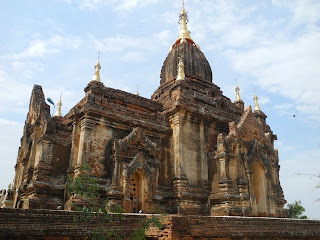No, it's not what you're thinking. I wish it were something racy but I finally got a bug the day we arrived in Bagan. Maybe it was all the in-and-out between hot and sticky Yangon streets and our no less than icy hotel and running around bringing my immune system to a halt. Nevertheless, it was just as stifling when we got to Bagan. After one day's rest, I didn't want to give up the opportunity to explore the 104 square kilometer plains full of temples, stupas and monasteries.
Bagan, formerly Pagan, was established in the late 9th century as the capital of the Pagan empire. From the 11th to 13th centuries it thrived as a center for religious as well as secular studies. For over 250 years, the rulers and subjects constructed over 10, 000 religious buildings, whereby a little over 2,000 currently remain. Repeated Mongol invasions in the late 13th century finally led to its collapse.
In the 1990's the Myanmar government made an effort to restore many of the earthquake damaged temples and stupas and make Bagan a major tourist destination. However, during the restoration process, they used modern materials and inaccurate architectural styles that appalled many art historians, and preservationists as well as keeping it on the tentative list of world heritage sites. To make matters worse, a modern palace was built directly across from the original palace ruins, still being excavated today and a 61 meter watchtower in the middle of the plains. Despite the inaccuracies, Bagan is still a wonder when you climb one of the temples and look out onto the 2,000 temples scattered throughout.
 |
| Htilomino Paya |
 |
| Stucco detail |
There is no shortage of souvenir hawkers ready to sell you a carving, a marionette or paintings. Alex kept herself busy by the food carts and Myanmar's version of knock hockey.
 |
| Ananda Pahto |
 |
| Cool off with some water |
Buddhas, buddhas, everywhere, from traditional gold ones with fading frescoes to flat screened modern ones.
 |
| Flat screen Buddha |
 |
| Could those lights be from the Bowery? |
The old palace...
and the new one.
They don't call this the golden land for nothing. Gold stupas are EVERYWHERE!
Unfortunately, I was only able to see Old Bagan since I had to bow out the other 2 days due to a pretty bad virus. I did however, manage to finish The Piano Tuner, an atmospheric novel by Daniel Mason of an Englishman's journey to Burma in the early 20th century. Marc and Alex ventured out on horse cart to explore the central plains and Salay with its old colonial buildings and crumbling teak monasteries without me.
































































